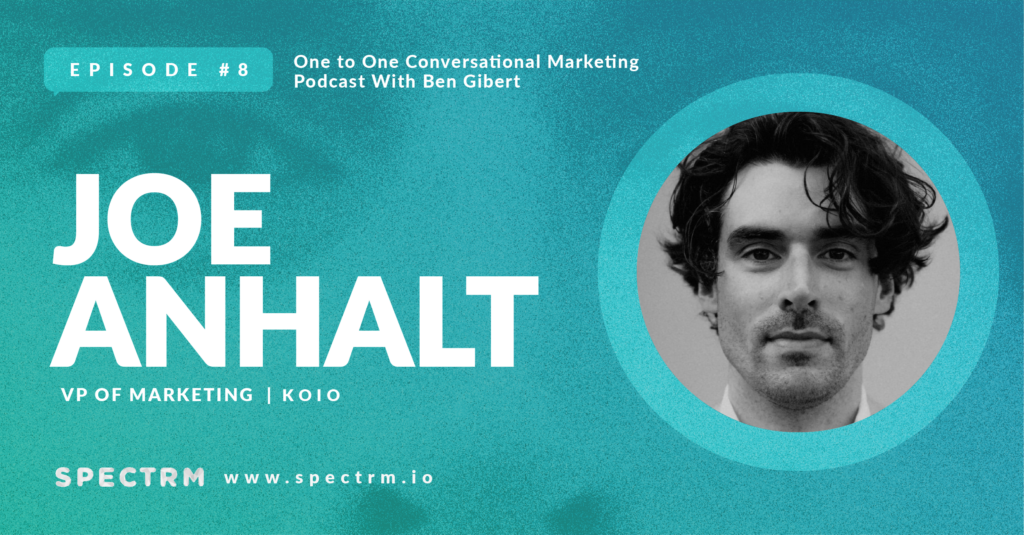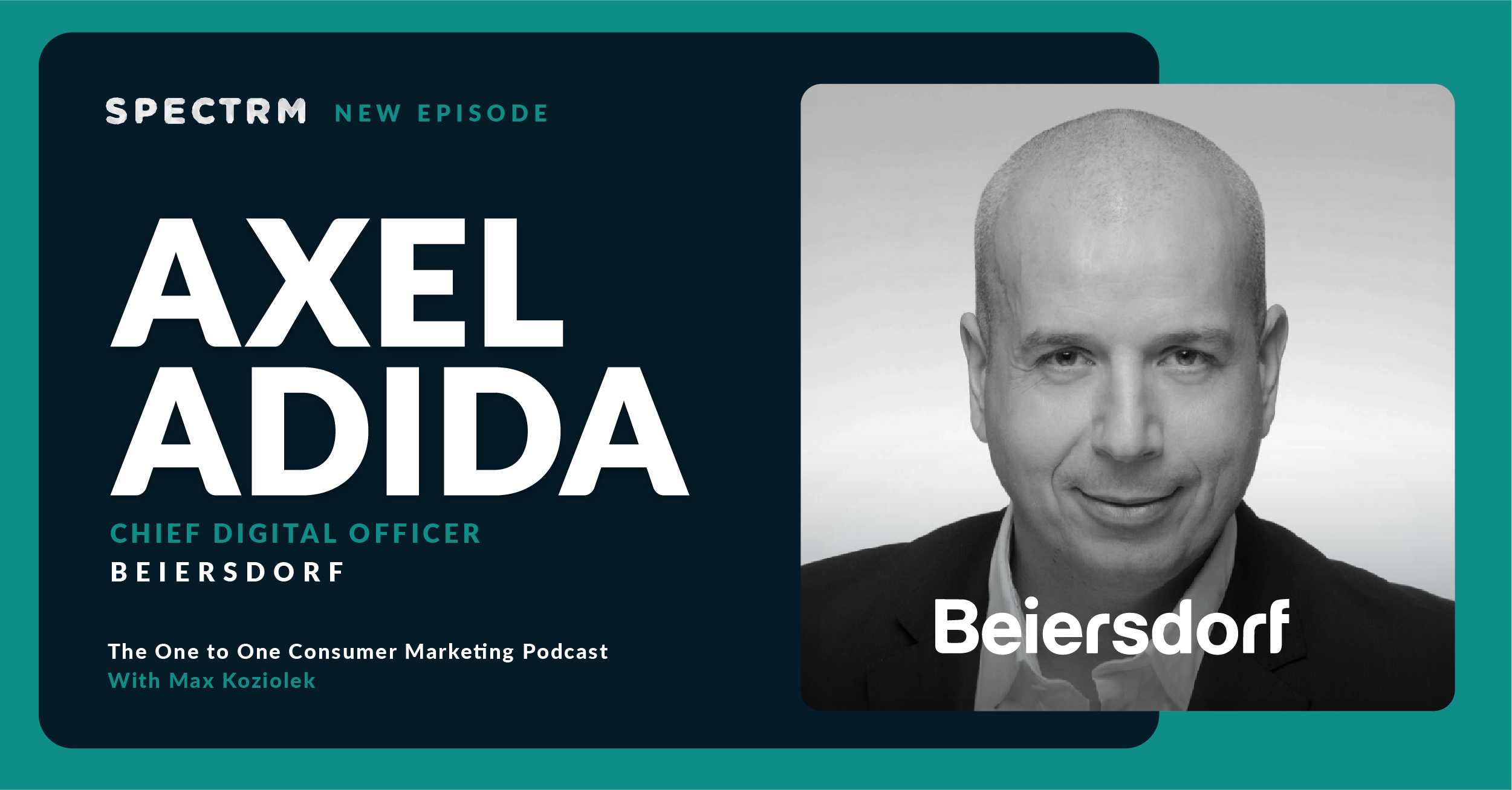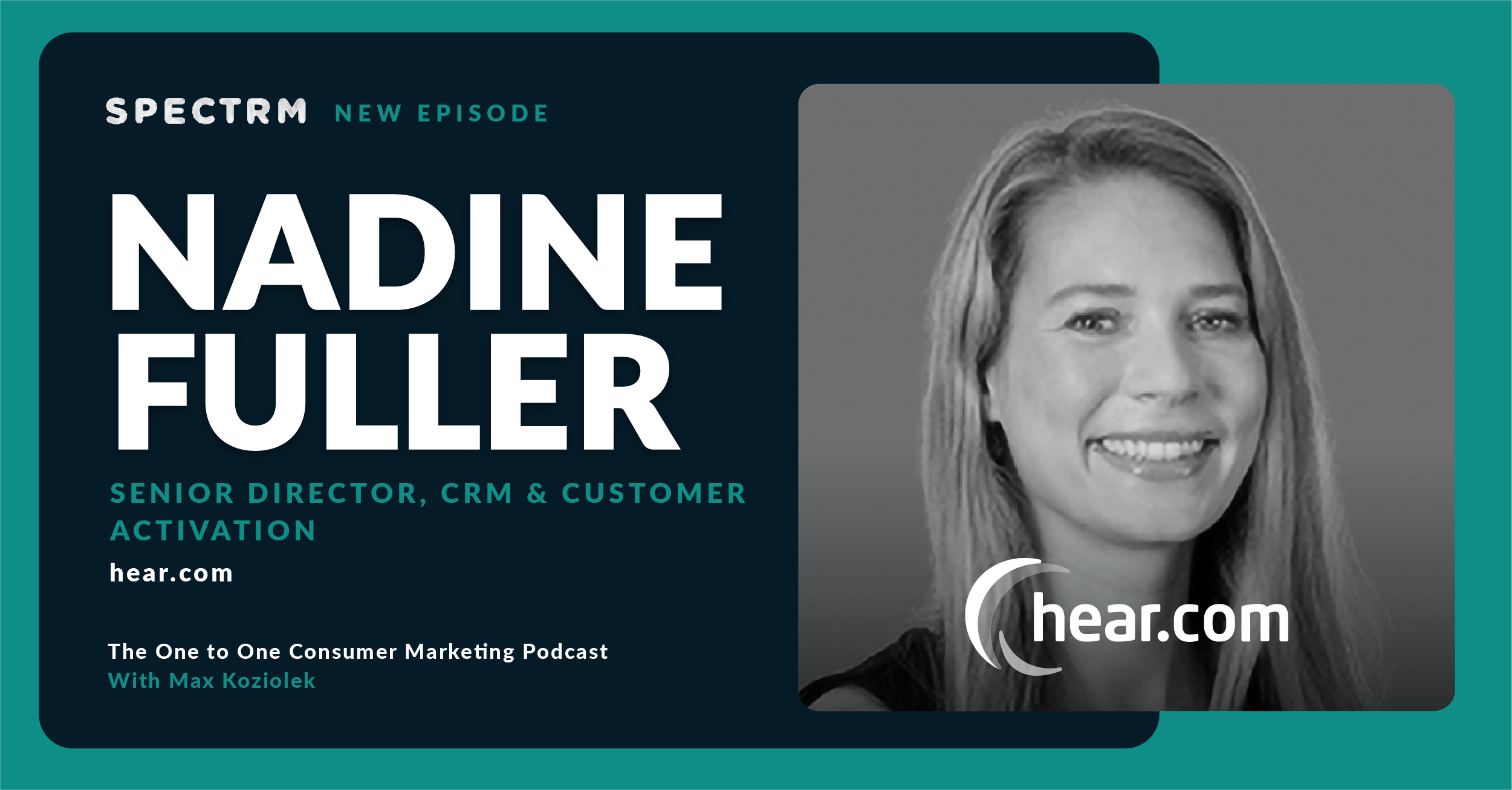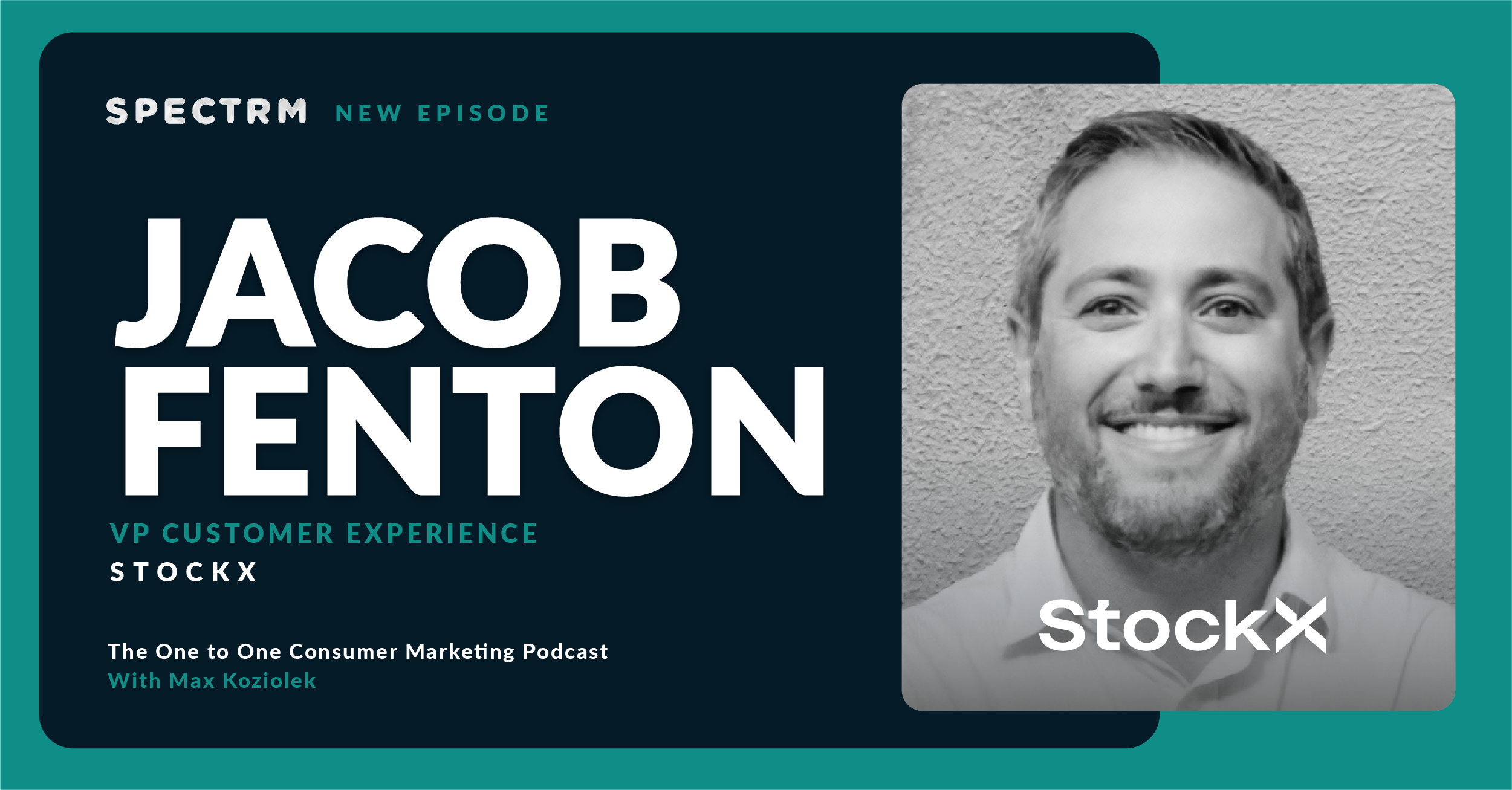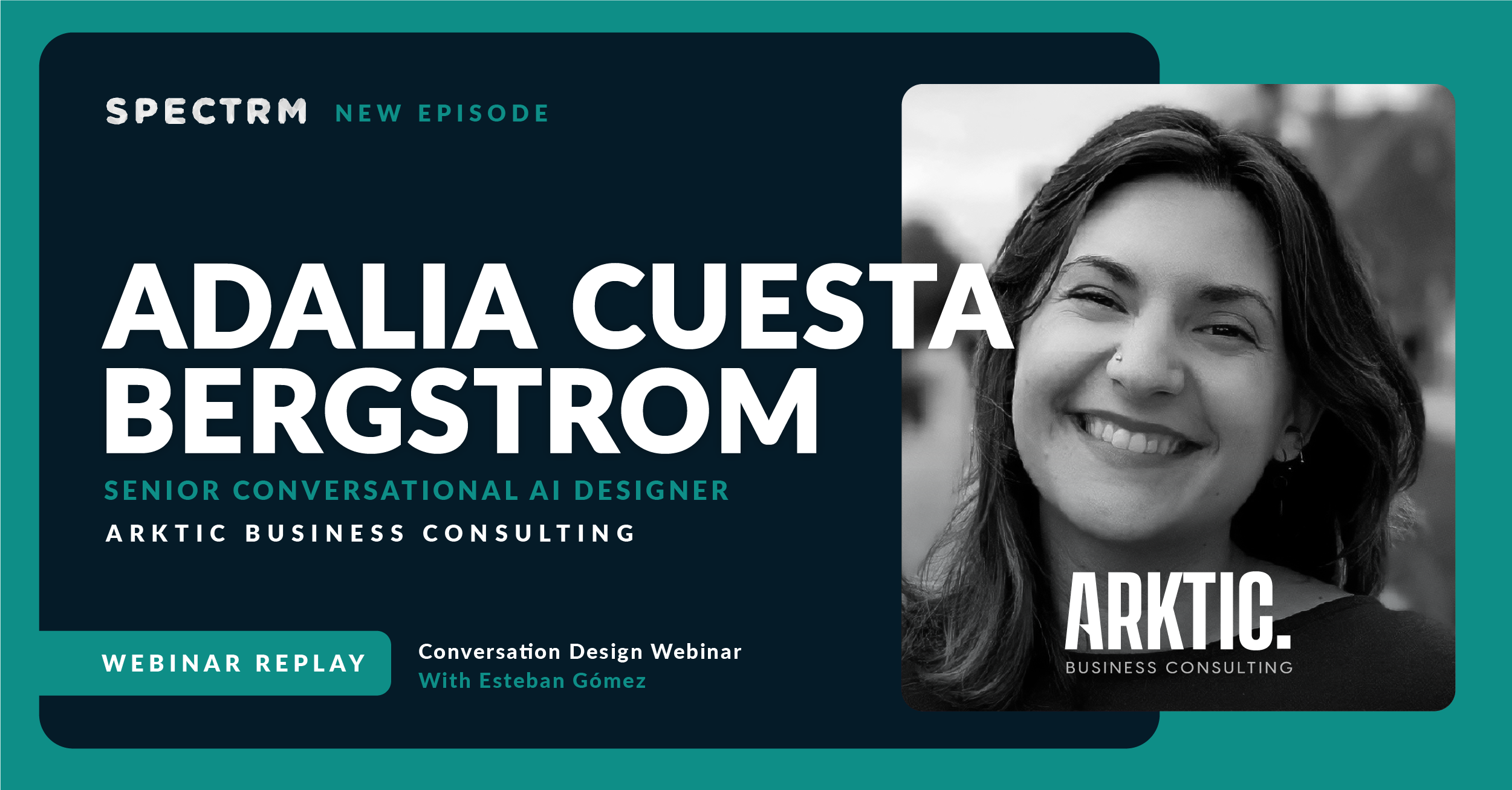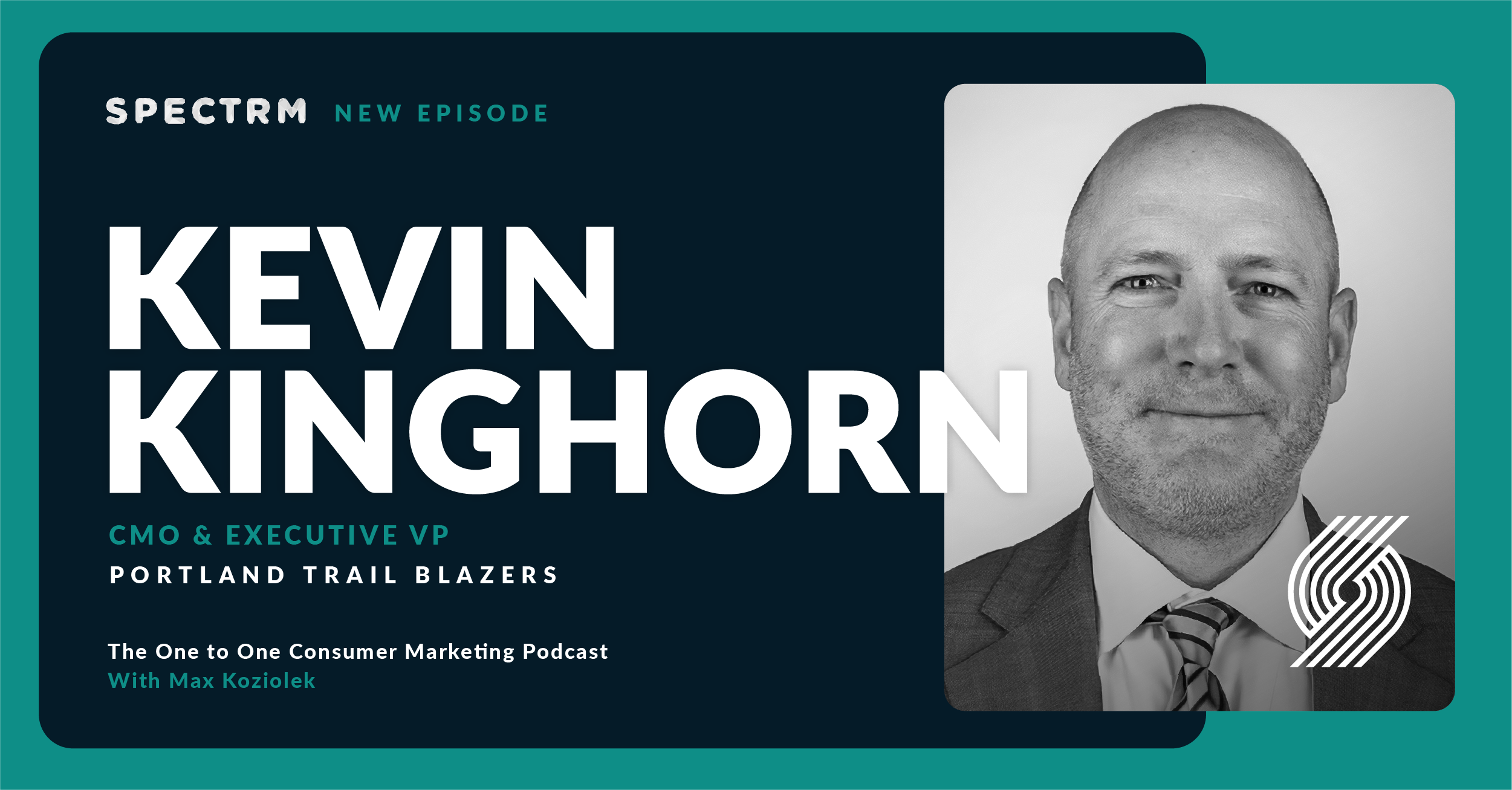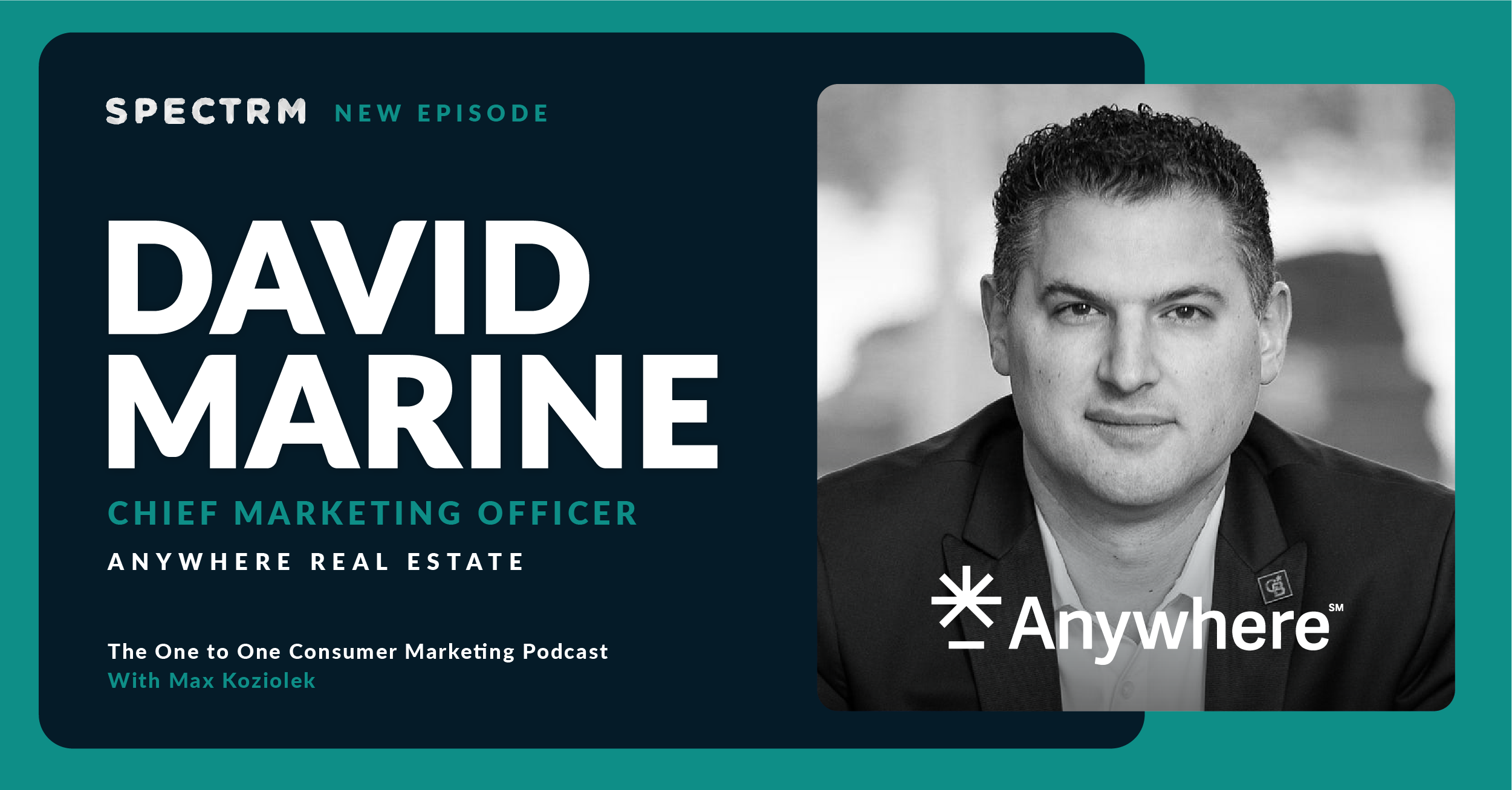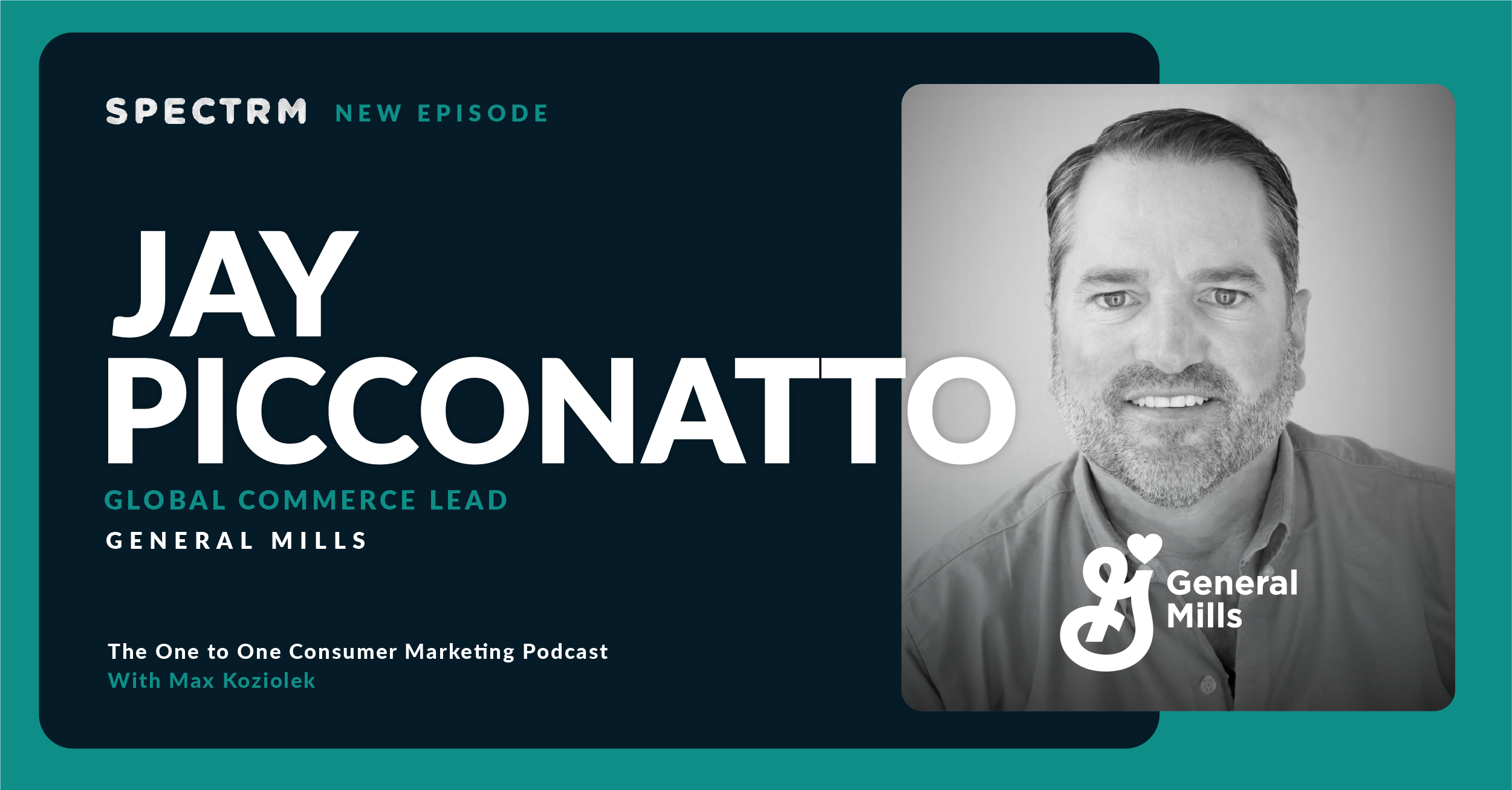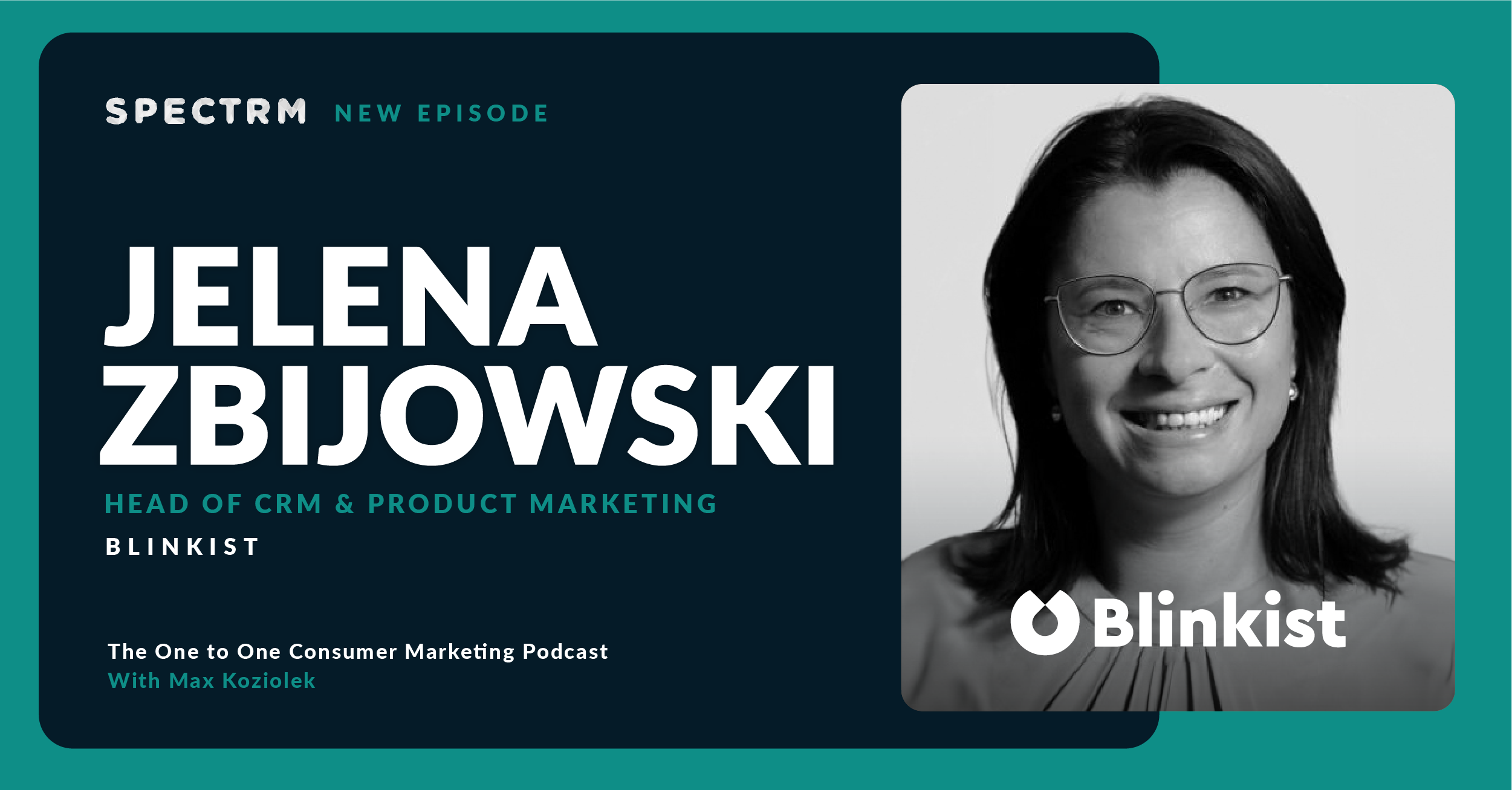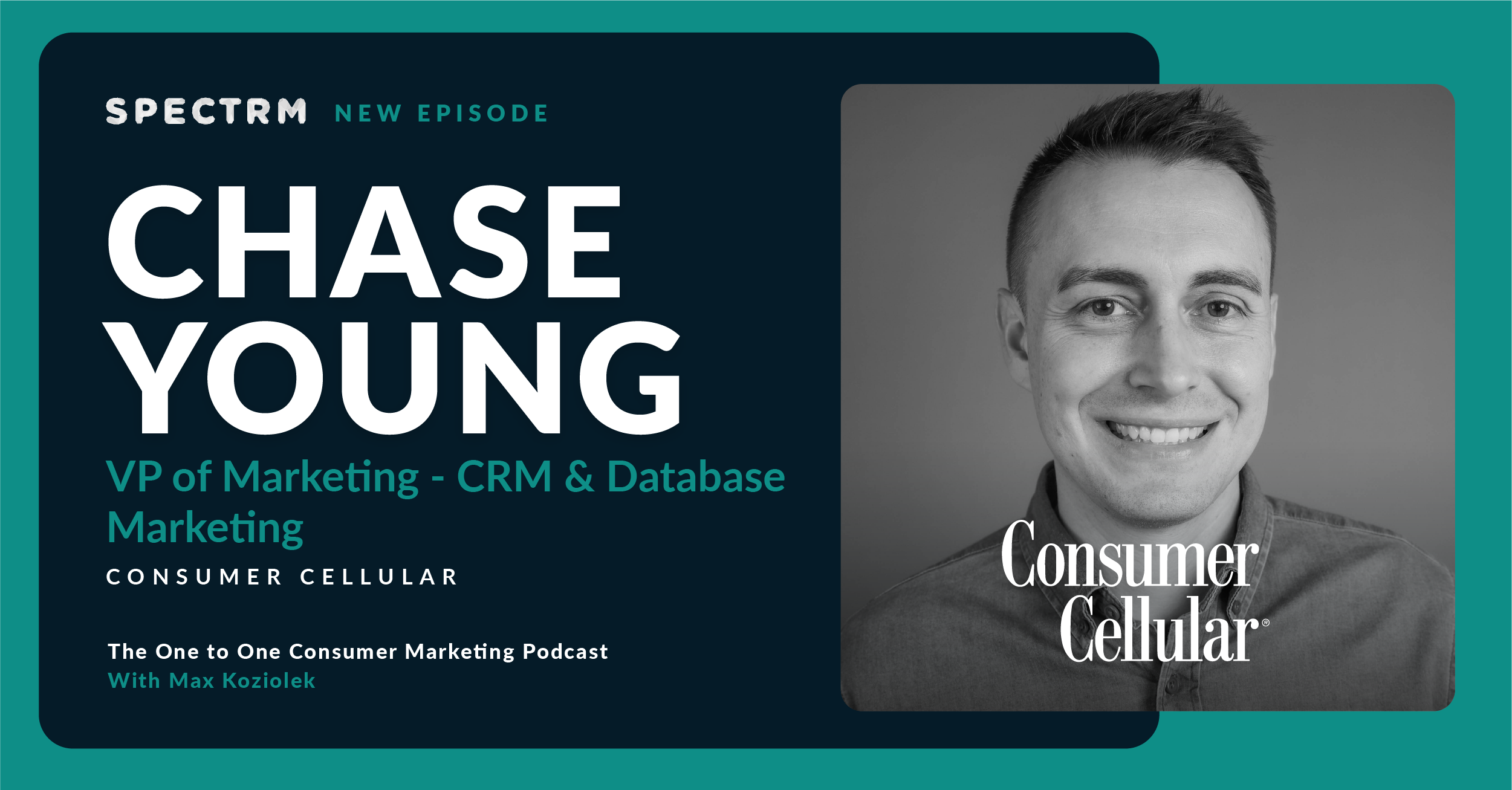Summary
On this episode of One-to-One Conversational Marketing, Ben speaks with Joe Anhalt, VP of Marketing at Koio. Joe has nearly a decade of marketing experience working with startups and more established organizations in the B2C space.
Topics discussed
- How Joe’s foundation in startups and massive growth helped shape his perspective on one-to-one marketing
- The importance of autonomy to execute on a vision
- First party data and the value of understanding who your best customers are
- Joe’s process of segmentation and cohort analysis to better discern the most important customers
- How being a media company first helps build affinity for your brand
- The channels Joe is seeing perform best and the data differences he’s seeing between them
- The trade offs between keeping your brand buttoned up versus letting it develop culture in the wild
- Marketing in an economic downturn and how to focus on the fundamentals of customer acquisition and lifetime value to grow a sustainable business
- Joe’s actionable advice on how to add more value to consumers by simplifying decisions, rather than adding to an abundance of choice
Guest biography
This has been a growing trend and I feel like it's still at its infancy, but I still feel like storytelling, content creators, social creators as well, with the TikTok world has blown up, obviously. Just think especially I'm speaking very specific to the D2C community and like the early brands, kind of the digitally native vertical brands to steal and old school Andy Dunn Verbiage, we are essentially all becoming these entertainment companies and entertainment firms. How can we capture people's attention through content that is entertaining first and foremost?
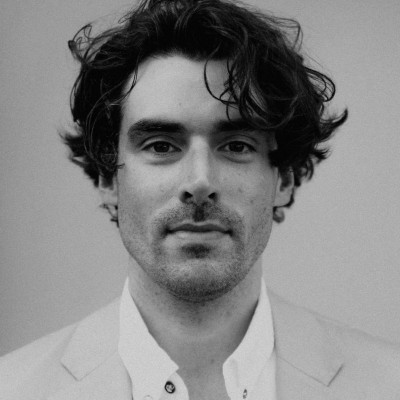
- I’m a full-stack marketer with 12+ years of experience growing DTC brands and marketplace startups. I can simultaneously be a storyteller and a bean counter.
Company overview
Constructed with the finest calf-skin leathers and hand-finished with unrivaled attention to detail, Koio products truly embody the spirit of their inception: they are ready for any journey—whether it’s the streets of a foreign city or an unexplored road home.
Industry: manufacturing | www.koio.co
Subscribe to the podcast newsletter
Transcript
00:00
Welcome to One to One: The Conversational Marketing podcast dedicated to helping modern marketing teams succeed in a messaging first and privacy first world. In each episode, we’ll interview a marketer who is winning with conversational marketing to distill best practices, lessons learned, and actionable takeaways. Here’s your host, Ben Gibert, VP of Marketing, Spectrm.
00:32
Ben Gibert
Hey, everyone, and thanks for listening to One to One: The Conversational Marketing podcast. Today I’m speaking with Joe Anhalt, VP of Marketing for Koio, a luxury footwear brand. Joe, thanks for chatting with me today.
00:45
Joe Anhalt
Yeah, excited to be here. Thanks for having me, Ben.
00:47
Ben Gibert
Yeah, no, it’s great to have you on the podcast, I think. Seems like you have a lot of digital marketing background and a lot of different fields I’d love to dive into, I think. Before we get started, can you tell us all about yourself, your background, and how you ended up your current role as VP of Marketing at Koio?
01:03
Joe Anhalt
Yeah, absolutely, happy to. As were just speaking before, originally from the Midwest. Grew up in a town called Normal, Illinois, about 2 hours south of Chicago, and went to DePaul University for undergrad as soon as I could get to the “Big City.” Yeah, wanted to get there as soon as possible. After undergrad, got in early at a tech startup, and that’s really where I first drank the startup Entrepreneurship Koolaid. It was at a company called Spot Hero, which if you’re from Chicago and the Midwest, that means something to you. It’s not as well known around the country. Also, if you have a car, you’d probably know about it. I was, I think, employee three or four there. They had just finished Accelerator Labs, which is now Techstars, and just kind of rocket ship trajectory growth. Was there just for three years, but saw massive growth, the company side and me personally, right.
01:57
Joe Anhalt
I started just as like a copywriter and kind of quote unquote content creator, which didn’t really exist back then, but that turned into email marketing and organic social and understanding, some paid social and paid search. A lot of SEO work and really just kind of the full funnel. How do we acquire customers, how do we get them to stick with our products? Right at that time, we had yet to even launch a mobile app, so it was fun to kind of be through that early journey as well. It’s kind of crazy to think that were slow to develop an app. Anyway, it was a really fun learning experience for me. Again, really drank, started Koolaid and were working at Coworking Space, and after a few years there, just wanted to work at a firm that was a bit closer to my interest in lifestyle. Wasn’t the big fan of the parking industry.
02:46
Joe Anhalt
Still have a lot of friends that work there and obviously appreciate everything learned, but shifted my attention to the kind of more traditional ecom D2C space and worked at Interior Defined. It’s a furniture retailer also based in Chicago. They’ve exploded through the pandemic, opening a lot of retail stores around the country. It’s becoming a bigger name within that category and did a lot of the same things that I was doing before, but got to implement them at Interior Defined was the first marketing hire there. Really navigating a lot of not just performance, but also on the brand side, working with the founder positioning and how do we pitch the brand to people and kind of the value proposition, which is this highly customizable furniture option which is not well known in the market at the scale were trying to execute. That was again a really fun moment for me and my career.
03:37
Joe Anhalt
After that just wanted a geographical change. I moved to New York four and a half, five years ago and I told myself I didn’t want to do another early stage consumer brand, but just kind of fell into Koio and have been really fortunate. So, yeah, started there. The former head of marketing had left about a month before I moved to New York and they were looking for somebody with a similar skill set and spoke with Johannes and Chris, the founders, and they sold me on what they were building. It was again just exciting to take everything that I’ve learned and implement it from the ground up at Koio. So, yeah, that’s what I’ve been doing for the past four and a half years. It’s been a journey through the pandemic. Selling $300 luxury shoes was a challenge, but I’m really fortunate to have been able to live through that and work through that right.
04:23
Joe Anhalt
Especially in our space and in our category. It’s been a big challenge. Yeah, that’s how I got to where I am today.
04:29
Ben Gibert
Nice. Yeah. Thank you for that overview. I’m sure we can get into some of the challenges that you’re seeing or that you kind of live through with the pandemic at Koio as well. I think just for listeners out there. I’m also based in Brooklyn, as you probably know by this point, but I’m currently in the Midwest as well. I’m in Michigan up north. I think I have some affinity for the brands you’re talking about and also Chicago in general. You mentioned having the background in SEO Paid Social, then working on the brand side more. I would love to dig into. You mentioned you didn’t think you’d work at an early stage D2C Venture again, I can imagine maybe some of the things that make you not want to do that, but what convinced you or what were some of the things that originally put you off that?
05:13
Joe Anhalt
What put me off to it was I just had done it before. I had been from zero to five a couple of times before and I wanted to sink my teeth into a more established firm.
05:24
Joe Anhalt
Right.
05:25
Joe Anhalt
Somebody who has deeper pockets to play with.
05:27
Joe Anhalt
Right.
05:28
Joe Anhalt
When you’re an early stage company, you’re really scrapping for every new customer, for every window of opportunity to optimize your acquisition costs and improving your repeat rates and things like that. As anyone knows, it’s just a grind.
05:42
Joe Anhalt
It really is.
05:42
Joe Anhalt
Every day, how do you sit down and think, how can I grow this business as efficiently as possible?
05:47
Joe Anhalt
Right?
05:47
Joe Anhalt
You literally have everything at your disposal, but you have no resources, you have no financial pockets, you have no team.
05:56
Joe Anhalt
Right.
05:56
Joe Anhalt
You really just have to be very scrappy. I was like, Do I want to do it again? And I thought, no, I don’t. I wanted to do, like, agency route, bigger firm, but every time I kept knocking on these doors, I just wasn’t super excited. The ability to step into a leadership role at Koio and really help steer the shift and just have more autonomy. I still to this day, wanted to join an early stage firm and build it to an exit right. At Spot Hero, at ID, I only got a snippet of that early stage and I didn’t see it through the end. That’s what I’m putting a lot of value in right now, is being able to be part of that entire journey, that entire arc, and I will say it does take a bit longer than I thought. Again, just being naive and not having experience, I thought were going to be just kind of this I hate to say, like the cliche, like the Unicorn or that rocket ship started, but the reality is the market that we’re in, our price point also, obviously, the macro climate of COVID that just isn’t a reality.
06:57
Joe Anhalt
Right, yeah.
06:58
Joe Anhalt
But back to the main question. I was just excited to be the leader and have more autonomy and work with Chris and Johannes, who just really appreciated their background as well and thought I could learn a ton from them. I’m still really pleased with that decision. It’s definitely been a roller coaster for the past four or four and a half years.
07:15
Ben Gibert
Yeah, I believe it. I think, like I said, it’s always the opportunity to learn is an exciting one as a marketer right. To join, not necessarily having the deep pockets, but like I said, having the autonomy to actually implement a vision and move really quickly is what’s appealing. And that from seed to IPO. We all love to think that it’s a straightforward rocket ship trajectory, but I think it usually comes down to a lot of luck and good timing too. I think a pandemic inflation and all kinds of supply chain issues what’s going on right now. I’m sure there are plenty of roadblocks along the way to that rocket ship journey but yeah, I think you touched on something that I feel myself too at Spectrm.
07:55
Joe Anhalt
Right.
07:55
Ben Gibert
The ability to move quickly. Like, you don’t always have the deepest pockets, but it can also be a lot of fun to build that brand and develop the journey along with the founders as well. I think seeing where you’ve kind of come from, the different marketing disciplines that you’ve had experience that had the chance to learn through what are you seeing today? How would you summarize the current state of digital marketing and what are some of the things that are on your radar at Koio?
08:21
Joe Anhalt
This has been a growing trend and I feel like it’s still at its infancy, but I still feel like storytelling, content creators, social creators as well, with the TikTok world has blown up, obviously. Just think especially I’m speaking very specific to the D2C community and like the early brands, kind of the digitally native vertical brands to steal and old school Andy Dunn Verbiage, we are essentially all becoming these entertainment companies and entertainment firms. How can we capture people’s attention through content that is entertaining first and foremost?
08:57
Joe Anhalt
Right.
08:58
Joe Anhalt
I think that’s been true for a few years, and I think that’s going to be true for the near term.
09:02
Joe Anhalt
Right.
09:02
Joe Anhalt
It’s kind of this race to build some type of entertainment company entertainment brand content first, right. Especially in our category of footwear. It’s extremely competitive.
09:14
Joe Anhalt
Right.
09:14
Joe Anhalt
You can get a pair of white sneakers literally anywhere at any price point.
09:18
Joe Anhalt
Right.
09:18
Joe Anhalt
So how do we tell our story? How do we craft that narrative? How do we match the perceived value with the actual value of our product?
09:25
Joe Anhalt
Right.
09:26
Joe Anhalt
I think that’s been a growing trend and is still very important today. Also this rush to first party data, right. And really understanding your customers. More importantly, something that has kind of hit me in the past six to eight months is understanding who your best customers are and try to find more of those people.
09:44
Joe Anhalt
Right.
09:44
Joe Anhalt
Not every customer is worth the same amount of time that you should give them. Somebody who buys once versus somebody who buys ten times. You need to be spending ten X more time and effort on that customer as opposed to the person.
09:57
Joe Anhalt
Right.
09:57
Joe Anhalt
Not all customers are created equal. I really don’t like the old school. The customer is always right because that one time purchaser versus that ten time purchaser. Sorry, but that person is not right in my eyes.
10:09
Joe Anhalt
Right.
10:09
Joe Anhalt
I really don’t have the time or the bandwidth to dedicate ten X time on that person.
10:14
Joe Anhalt
Right.
10:14
Joe Anhalt
It comes down to understanding who that ten X customer is. And that’s really hard.
10:18
Joe Anhalt
Right.
10:19
Joe Anhalt
Especially with little to no software tools to help define this. It’s a lot of just hacking through spreadsheets and pivot tables and building out your own cohort analysis and things like that. A lot of customer surveys and getting on the phone with people or just talking to people in stores, if you have that, those fundamentals are still very key.
10:37
Ben Gibert
Yeah, absolutely. I think you touched on a lot of great things there from, I guess, D2C. The D2C brands were really kind of born of social, right, and of owning that customer data and owning the relationship with their customers directly. Also, I think, are so used to being super agile, right, like turning performance channels on and off. Being able to just move at the speed of light is the strongest benefit. There’s also the need to also maybe take pause and think, okay, like, straight up customer acquisition is not always the goal. Let’s think about lifetime value. Let’s think about how we grow revenue per customer and let’s double down on the customers that we get the most money from. Right, so I think you mentioned kind of hacking together through spreadsheets, not using a lot of tools. You kind of answered part of my next question, which was going to be, how are you doing that segmentation, the cohort analysis?
11:26
Ben Gibert
How are you doubling down on those most successful customers? Can you talk me through a bit of your process? Maybe once you’ve identified a really high value cohort, what’s kind of the next step that you use to activate it?
11:38
Joe Anhalt
I’d say we have a ton of learnings on the I’d say like top tier veneer of cohort analysis. So monthly, by acquisition channel, so we have 30 essential right now, like wholesale, which is a very small part of our business, ecommerce, and then retail as well.
11:55
Joe Anhalt
Right.
11:56
Joe Anhalt
Of those three kind of customer segments, which ones are yielding the biggest bang for buck? What’s interesting is even just looking at those three variables and then month over month, we can understand what initiatives we had firing, let’s say, January of last year, right, okay. Their lifetime value is 23% higher than months surrounding that. You kind of continue asking those questions and just digging a bit deeper.
12:20
Joe Anhalt
Right.
12:20
Joe Anhalt
Oh, we had a sale the month prior and then maybe we had a new product launched the month after that.
12:25
Joe Anhalt
Right.
12:25
Joe Anhalt
You can start to see like, oh, this is forming a recipe for success.
12:29
Ben Gibert
Right?
12:30
Joe Anhalt
Yeah. We’ve got really good I’d say that’s baseline monthly and then by channel first channel order, let’s say. less about acquisition channel, I’d say, but where does your first order take place? The next layer for us, we do sell both men’s and women’s products.
12:47
Joe Anhalt
Okay.
12:47
Joe Anhalt
By gender.
12:48
Joe Anhalt
Right.
12:48
Joe Anhalt
What I’d love to do next, which we’re trying to work towards with support from a few other startup, tools, is by channel.
12:57
Joe Anhalt
Right.
12:57
Joe Anhalt
A Facebook acquired customer versus search versus affiliate versus creator.
13:02
Joe Anhalt
Right.
13:03
Joe Anhalt
And once we get there. I’ll feel really confident in understanding who the best customers are and what that recipe is, just fine tuning that recipe. One thing that I know we can get better at as well is just literally asking people, we have a post purchase survey, where did you first hear about us? Things like that, but just emailing people, like getting on the phone. We’re still relatively small, we have a lot to learn, and I feel like those types of conversations are always valuable. As a market, you’re never going to regret talking to a customer and getting some anecdotal evidence and data points, right? It’s not going to be the end all, be all for driving everything you do, but it’s just another data point that can again help crystallize this recipe that is ongoing and never finished.
13:47
Ben Gibert
Yeah, I think digital marketers today, they love we’re all into hardcore conversion rate optimization, like AB testing, multivariate testing, doing all the landing page stuff personalization, and that’s great. It does help you lift conversion rates piece over piece, but ultimately, sometimes you get the best insights just from going out and talking to people that are using your product, and it’s easy to forget that piece of it. I want to maybe go back to something you said in the previous answer too, which is like, all companies should be media companies, because I think it’s something that’s true for pretty much every industry you’re in now. I feel like I’m in B2B.
14:21
Ben Gibert
Enterprise, SaaS and Marketers in that space too. That’s how you differentiate your brand, right, is embracing content and embracing the fact that you should be a media company first, and that’s how you build affinity with your brand as well. Can you maybe walk through some of the things that you’re doing to do that? You also mentioned that you kind of have this distinction between different channels, like whether it’s wholesale, retail, ecom, things like that. Can you speak to what channels you’re seeing perform best and maybe the data differences between them? Since you talked about first party data, I’m sure that some channels yield more data to allow you to fine tune that recipe that you mentioned too.
14:59
Joe Anhalt
For sure, yeah. At Koio, we’ve really just turned everyone into a content creator because the reality is that it’s really hard too, to always be churning out this type of content and be entertaining and be valuable. We’re also not all professional creators, right? Not every piece of content is going to be five out of five. Some are going to be good, right? We understand the value and the importance of it. Really, people, especially in footwear, there’s always going to be friction in sizing. That’s always going to be an uphill battle for us and returns, which is one of our biggest challenges and has been one of our biggest challenges from day one. We’re always trying to do things to mitigate that. People want to see the product in action, in motion. If you’re a female customer, you want to see it styled. If you’re a male customer, you want us to literally rip the shoe in half and tell you each component of it, right.
15:50
Joe Anhalt
Where the material is sourced from, what kind of stitching we’re doing, what the are that we’re working with. Is it chrome, six tanning, or something less?
15:58
Joe Anhalt
Right.
15:58
Joe Anhalt
Is the leather LWG certified?
16:01
Joe Anhalt
Right?
16:01
Joe Anhalt
That takes a lot of communication, and no one wants to read a white paper from Koio about our sustainability efforts.
16:08
Joe Anhalt
Right.
16:09
Joe Anhalt
You have to make it entertaining and fun. Nine times out of ten, that means it’s going to be a video, a talking head, animation, an interview. We’re in one of our factories in Italy or something else like that, right. It comes down to that entertainment, that education, and that helps, obviously, differentiation. Really, again, if you’re able to capture somebody’s attention, we’re still very much in the attention economy, and creators are the best at cultivating and capturing that attention.
16:42
Joe Anhalt
Right.
16:42
Joe Anhalt
Because you can just make entertaining stuff. So, yeah, everyone’s become creators. We’re always thinking about, like, hey, what can we do different? What fun idea can we do? Our brand has been pretty buttoned up for a while. We want to be this luxury, more striving to attain this lifestyle. Because of that, our content production hasn’t been as easy to come by. Honestly, TikTok has allowed us to be more casual and just churn out more content for us. That’s been fun for us, is just to be a bit more casual. What that does is, again, just lowers the threshold for us to produce content, because we can do that with an iPhone now, with no budget, as opposed to hiring a videographer or a full production that costs $5, $10, sometimes $15,000. That’s been a big shift for us culturally. It’s been fun. It’s been a little scary getting behind the camera and sometimes getting in front of the camera.
17:35
Joe Anhalt
It’s also been a fun kind of team bonding for us, just like pulling people aside, thinking through ideas. It’s really fun to do that in the office.
17:44
Ben Gibert
Yeah, I want to. Before you move on to the other part, I think I’ve talked to a lot of people, even on this podcast, too, where they mentioned that, right, the trade offs between trying to keep everything so buttoned up, really honing the brand, trying to control the brand, versus letting the brand kind of run wild in culture, in social. I think that what you’ve touched on, too, like the ability of TikTok to lower the threshold of production and ultimately probably make it more fun. I’m sure your customers feel that, too, in the types of content that come out. It probably comes across as more authentic to that extent too.
18:20
Joe Anhalt
Yeah. It’s allowed us to react to certain trends quicker.
18:25
Joe Anhalt
If we see maybe one of our past collaborators come up in the news, we can bring that story back up to the forefront and it’s relevant. That’s also been something that’s been nice. It’s just the ability for us to move quicker because we don’t have these high production standards anymore.
18:39
Ben Gibert
Yeah. Going back to, I guess, the other question in terms of some of the channels that you’ve seen work best versus least and maybe some of the differences you mentioned first party data and kind of what you can collect and then how you can act on that data. Can you talk to us about that?
18:53
Joe Anhalt
Yeah, for sure. In terms of like acquisition channels, paid social is still working for us quite well. Facebook, Instagram, we’ve made our first in house acquisition like manager hire, which has been fantastic. We shifted away from agency world to in house. Yeah, our ROAS increased our cost acquisition decrease just because these platforms take little pushes and pulls every day and they take that maintenance, I’m sure better than anybody and just having somebody all day every day kind of fine tune, that has been a big win for us. Even with the lack of or having less data, we’re still seeing that platform do a lot of the heavy lifting for us.
19:31
Ben Gibert
Right.
19:31
Joe Anhalt
Another interesting channel for us that we have continuously seen work is YouTube. Back to my point about how our male customers specifically really want to do a deeper dive on our products. This is a considered purchase, a $300 sneaker. We have a ton of boots coming out this fall. They’re going to be $350, some $400. That’s a considered purchase. You’re not going to see Facebook ads, somebody jumping around and then boom, you’re going to buy, right? You’re going to do your research. Guys love to go to YouTube, that’s just the reality of it. They love to do deep dives. It’s interesting I mentioned this before, but our post purchase survey, one of the questions is before you first hear about Koio and pretty high percentage month over month, it’s YouTube, right? It’s people using that as their main search engine and then watching videos of these creators doing a deep dive on our product.
20:22
Joe Anhalt
We’re trying to double down on that scaling. That obviously is challenging because you have to work directly with these creators. That’s what I’m to be clear, I’m talking about working with creators less on preroll ads, midroll ads, things of that nature. We don’t see as much success with those efforts. Really finding these fashion and boot experts and sneaker experts, you’d be surprised at how deep that well is on YouTube. Yeah, it makes sense because again, our customers want to do a lot of research and some due diligence on the product that they’re going to spend three, $400 on before they buy. Trying to double down on that, it is challenged to scale just because it’s a lot of like it’s like a sales process. You have to find your prospects, negotiate, execute, follow up, understand if the campaign worked or not. YouTube, those have been two really strong channels for us for some time now.
21:17
Joe Anhalt
We’re still trying to get TikTok to work, paid and organic. We’re out there trying every day, but we haven’t hit a home run there. Lately this is like very specific one, but it’s top of mind. I was talking with our head of acquisition. Google is transitioning from Google Shopping to Performance Max and I don’t know if any other marketers out there are struggling with this, but it’s very black box. Google is not telling us much. That’s been a struggle for us as of recent. Again, not like a huge channel that we can scale, but we do see a decent amount of consistent performance from that week over week on top of months. Josh and I, Josh the head of acquisition, we’re both just kind of scratching our heads. If anyone out there is listening and wants to shoot us a note to help us out or just kind of navigate this together, let us know.
22:02
Ben Gibert
You heard the man, DM him on LinkedIn or you’ll find out his contact details at the end of the day. If you have an insight, please share and I’ll pass it on if I get it too. I think that Google Performance Max one is a good one, right? Because that’s the evolution of where these channels are going, right? They are trying to become black boxes and trusting the algorithm is what they are pushing for. It’s what they’ve always done. I think you’re seeing it more and more and the messaging around it from the platforms is also like, you will get stronger performance if you trust the algorithm. We also all know that you see it a lot of control. Like you said with Facebook, I’m shocked that your agency wasn’t in your account every single day trying to do the best for your brand.
22:47
Joe Anhalt
We definitely work their largest plan, so I get it.
22:53
Ben Gibert
Yeah, going in house gives you more of that control, also lets you understand what are the levers that are working right? How do we, like you said, in the way that you double down on the ten X customer, how do you double down on the creative that works? That’s something that does require a lot of manual work. I think the YouTube one is also interesting. Like you said, it’s about that deep dive. If you’re a considered purchase, you have probably a longer buying funnel. You have maybe longer time to purchase and it’s like more research involved and particularly in a world where there’s like 1000 different brands that someone can choose to buy from. It’s also like getting the people that have the audiences where they can tell a message, can tell a story that resonates or can highlight the product feature that resonates with them, that has a lot of power.
23:37
Ben Gibert
I’m not surprised you see that work. Thank you for sharing that with our listeners because I think there’s a lot that can be unpacked there for other brands, too. As far as personalization is concerned, there’s so much stuff out there as well. I think the customer experience and personalizing that experience is something that is a huge challenge. Operationally to scale, that is a challenge. How are you doing that at Koio? Are you doing any of it? Are you seeing success with that and kind of what channels are you using to do that?
24:09
Joe Anhalt
Yeah, honestly, we’re certainly not doing enough. I wouldn’t say like one to one personalization. We have the standard abandoned cart flows and browse abandoned and we can pull in specific products. Each person who gets, like, let’s say you go to a product listing page and we send you a note after like, hey, what do you think about these? That email is going to be different just because all the products are going to be different, right? We see those work really well, right? I’d say that’s the best we’re doing in terms of one to one personalization, again, that’s more of like little buckets here and there. And I know that’s the race, right? We all as marketers, you want to be as specific and as segmented as you can and how do you scale that, which is always challenging. I’m always talking to these tools and these softwares and they’re a bit more expensive than what we’re willing to spend right now.
24:57
Joe Anhalt
Also, I don’t want to discount the old school one to one conversation, the CX, right? The Instagram DMs in our physical retail stores. I feel like at Koio, and I think the larger D2C community dramatically intervalues retail and just physical stores, right? Especially like post pandemic. I do feel that people are going to be doing more in person shopping than online shopping. Just because you’re working from home all day, you do everything online. It’ll be like a treat to go into a store and buy. I’m always trying to keep that top of mind as well. Talking to our sales teams, how are our customers today, what conversations are you having and what are the main pain points? Which we know, right? It’s always sizing, it’s always price. It’s some style questions as well. Yeah, across the standard segmented, email flows, SMS flows, again, hand picking products based on the tools that we’re using and then like CX and retail and just having this constant feedback loop of what.
26:01
Joe Anhalt
Our customers are saying, that’s been important for us. That’s something I learned really early at Spot Hero, is just how valuable your customer feedback is and just like always working that into your conversations as a team and especially as a marketing team. That’s something that we just need to get better at, both the one to one and just always having that constant customer feedback.
26:21
Ben Gibert
Yeah, I think you’re definitely not alone there. It is a struggle for a lot of marketers and teams. I think we operate in that one to one messaging space. I think the Instagram DMs is one that we’re also seeing blow up a lot. I think I like how you connected that to retail as well, because the last episode that just dropped yesterday, actually, I spoke to the marketing director at Indocino and he was saying a very similar thing, right. He was using digital acquisition channels that work very well. What pulls customers in or what keeps them coming back is also like that offline experience and the joy that people get from that experience. I think there’s a lot of opportunities there too, just in messaging. Right. You can also connect to retail stores and tell people what’s in stock. You can actually scale that. There’s a lot of exciting things there.
27:08
Ben Gibert
Like you said, it does always involve bigger investments in software that require some larger budgets as well. I think the name of the podcast is One to One Conversational Marketing. I think there’s a lot of ways that can be interpreted, I think, for you. You mentioned one to one a few times in that answer as well. What does that really mean to you at Koio? I know you’re saying you don’t do enough of it, but what would the ideal scenario look like for you?
27:33
Joe Anhalt
I think we’re all striving to this perfect journey for the customer that’s just there.
27:38
Joe Anhalt
Right?
27:38
Joe Anhalt
Based on whatever data we can pull from the customer, they sign up for emails, they browse our site, they bought one product before. I want to store all that data somewhere. Every time they come to the website, it’s specific to their past behaviors.
27:53
Joe Anhalt
Right.
27:53
Joe Anhalt
Maybe the homepage hero is different, the homepage copy is different. The product listing pages are merchandised in a way that puts the product that they are likely to buy the most at the top of the page.
28:06
Joe Anhalt
Right.
28:07
Joe Anhalt
Maybe even to like, this is getting super one to one. Like on the PDP, let’s say it’s again. What we keep talking about this male customer who loves the videos, the PDP page, there’s actually a video of somebody doing a deep dive on the product, right. Because we know that they like that.
28:22
Joe Anhalt
Right.
28:22
Joe Anhalt
Literally, it’s like a different experience across the board.
28:26
Joe Anhalt
Right.
28:26
Joe Anhalt
If they have a CX question page or head of CX, she has all of their information pulled up. She can already speak to everything, not just their past orders, but some other data that we can just aggregate together by these behaviors that I think is super cool and interesting. Like how we make that a reality, I have no idea. I know there are probably some econ tech firms out there who can do this, right? This one to one experience. I think that’s the Holy Grail that we’re all striving towards. Right, but how did it make that a reality? I don’t know.
29:02
Ben Gibert
Yeah, absolutely. I mean, I think the buyer journey pulling in all the data points, it gets complex very quickly. I think we’ve actually worked with a lot of huge shoe retailers like Deichmann in Europe or like stadium goods in the US. Smaller brands, too. I think the struggle is also just activating the data, right. Like, collecting it is one thing, but then what do you do with it is always a struggle. We’ve seen, I think they’ve also used similar journeys to what some of the things you’re talking about. Let’s personalize the messaging journey in real time on Instagram and ask people, what’s your price point? What size do you want? What style do you want? That lowers the barrier because you’re not trying to just pull data from all of these different systems and find a way to activate it, but you’re just like, straight up asking your customer and then doing that personalization in real time.
29:48
Ben Gibert
I think there’s so many ways that you can actually do that it can feel overwhelming at times. I mean, you touched on a few different trends there or just developments in the marketing space. What is most exciting to you as far as looking forward? What’s like the most exciting thing in digital marketing? If you had unlimited budget or what would you want to be doing? Unlimited budget or even without unlimited budget, like, what do you have your eye on? What interests you?
30:14
Joe Anhalt
What I think is interesting is this is more like holistic. Not as specific to marketing. I think well, I guess it is like the fundamentals of and I spoke about this earlier, but the fundamentals of customer acquisition cost, lifetime value, return on ad spend unit economics. I feel like marketers, there’s always CMO roles are always like weird and convoluted and digital marketers and we’re of ecomm and marketing and brand and revenue and this, that, and the other. It’s been really fun for me to seek my teeth into the economics and just business fundamentals, right? So, again, more so within a marketing hat. It’s that customer acquisition costs and lifetime value and finding those heavy haired customers. That’s a really nice trend to see, I think very much past this sunshine and rainbows where venture money is flowing and it’s so easy to get checked. It’s so easy to acquire customers because Facebook was so easy and we had deep pockets because the market was so frothy.
31:18
Joe Anhalt
We’re kind of on the flip side of that, right? The market is the opposite of frosty we’re going through coming out of the pandemic. Recession is looming. You really have to have those fundamentals down. You really have to be trimming the fat, cutting the cost. On a marketing side, I think you also have to be trimming the fat and cutting the confusion.
31:39
Joe Anhalt
Right.
31:39
Joe Anhalt
You really have to get to the point a bit quicker. You have to provide as much confidence as you can in your customers as opposed to providing this whimsical story or an abundance of choice, right? People don’t want more choice. They want to be feeling more confident in one choice.
31:56
Joe Anhalt
Right.
31:56
Joe Anhalt
I like to call it like the in n out model, like the in n out burger. The menu is so short, right? There’s less decisions to make, which is actually just such a better experience for everyone. People don’t want to make choices. They’re really bad at it. So, yeah, I feel like the fundamentals of the financials and the economic side of your unit, economics and things like that are coming into the marketing world as well. Again, feel like I’m beating a dead horse now. With acquisition cost a lifetime value, understanding your customers, growing and building a sustainable business, right? I feel like a lot of players in the D2C space, it’s blowing up in their face right now because they can’t sustain the growth, they can’t fulfill the promise of whatever their brand was, right? We all know who the big ones are out there. There’s hundreds, if not thousands of those small ones that we’ve never heard of that are no longer around today, right?
32:49
Joe Anhalt
As a marketing organization, you can help lead that charge of building sustainable business and building that foundation because digital marketing today is becoming much more of a numbers game, right? That’s all it is, right? You have set costs, you have PNL. The fundamentals are very easy, but it really does take every day coming in with that approach and reminding yourself and kind of back to the top of the conversation sitting down like, how am I going to grow the business today?
33:16
Joe Anhalt
Right?
33:17
Joe Anhalt
More importantly, how am I going to grow it in a sustainable fashion? Which is really hard. Really hard.
33:22
Ben Gibert
It is. I think you really hit the nail on the head there with yeah.
33:27
Joe Anhalt
I mean, it’s easy to customer acquisition lifetime.
33:32
Ben Gibert
No, but I mean like the venture, it’s easy to show growth when you’re flush with cash from venture funding. Like anyone can show rising customer growth. Anyone can do that, right? What marketing leaders in particular need to do is show revenue growth. Show not just earnings growth, but like actual profit growth and show that you can grow, do more with less, right? I think marketing in a boom time when the market is frothy is not as difficult, right? Marketing in a downturn, you do have to go back to those fundamentals and ultimately, if you want to grow a sustainable business, that’s what you should be focusing on anyway. I think it’s actually kind of nice as a marketer that has happened because it does make you get better at your craft. It makes you really hone in on what matters. I think that’s a really important thing to focus in on.
34:16
Ben Gibert
I mean, maybe you’ve touched on it in that answer, but I think if you had your top three pieces of advice for marketers that are either marketing in a downturn or want to meet that consumer that is going to look for more recommendations like more advice on what to purchase versus how to add more value for the consumer, at the end of the day, what would be your advice?
34:38
Joe Anhalt
I’ve said a few of these and yeah, the top of my list was ask yourself how can I make my customers feel more confident in the purchase?
34:46
Joe Anhalt
Right?
34:47
Joe Anhalt
A few ways that we’ve been doing that at Koio is we know what our best sellers are, we know what our bread and butter is, right? Lead with that in fashion, in any retail company that has a lot of these new product launches coming every month, every week, that’s really shiny and fun to talk about. More times than not, what keeps the lights on is going to be that core product offering, right? So never lose sight of that, right? And continue refining that and optimizing that. The nice new shiny things are always going to be there. Think of that more so as marketing and acquisition. Really what keeps the light on it is that core product offering, right? So never lose sight of that. Double down on that. How can you again reinforce that confidence in that core product offering, whether it’s footwear or a SaaS product or whatever have you, double down on that.
35:38
Joe Anhalt
Again, in the spirit of trimming the fat prioritization and startups is key. I feel like it is talked about, but it needs to continue to be talked about. Figure out those priorities and stick to them. Because we can do anything and everything we want because there’s no checks and balances. That’s good, but I would say it’s more bad than good, right? As a leader, it’s hyper important to sit down with your team and understand the priorities and just remind yourself clearly every day, like here are the priorities and stick to those.
36:05
Joe Anhalt
Right?
36:05
Joe Anhalt
It’s essential to any business. I just feel like that needs to be said. One thing I want to come back to in terms of the marketing and consuming, we’re all in the entertainment business now, right? Put your creator hat on, or your creator shoes on, for that matter, and always be testing, always be experimenting and have this mentality of not everything’s going to work, but have fun with it.
36:28
Joe Anhalt
Right?
36:29
Joe Anhalt
There are a lot of D2C firms out there, ours as well. We’re not curing cancer here. I always tell people, like, I’m a shoe salesman, I sell shoes on the internet. Boil it down to that core offering and you can kind of let yourself go and have some fun with it. So, yeah, just kind of lean into that greater environment and have fun with it.
36:50
Ben Gibert
Yeah, I think those are great pieces of advice. I mean, reassuring customers by making them really confident in their purchase, not losing sight of the core product offering, to really lead with that because it ultimately will make the most revenue, even though you can offer the shiny thing and then the priority one huge. I think working at a SaaS startup myself, there’s a billion things you could be doing. It’s easy to just try to do all the things at once and it’s a really good way of doing all of them poorly. Just doubling down on that and even doubling down, I think on your strengths as well. What are you good at and use that to your advantage? I think lots of things that our audience could definitely learn from. I mean, we’re getting close to the end of time, so I want to also let you go .
37:33
Ben Gibert
I know we’re after time, but I think I’d love to hear, like, five years from now for you, what’s, like, the future of marketing look like for consumer brands like Koio.
37:42
Joe Anhalt
Yeah, I feel like this is where I’m supposed to talk about, like, Web3 or the Metaverse, but oh, please don’t. I feel like there’s way too many unknowns anyway. I don’t have anything to say about that, but I’m honestly curious to see if we’re going to flip from this fluffy brand story to the complete opposite of this QVC style selling products just like, more black and white and just like, yeah, less of a fluff, less of the Adam Newman’s of the world. I feel like entrepreneurs and startups right now. It’s very vision and brand led. I’m really curious to see if we flip to, oh, I want your CEO to be like an ops person, like more of a Tim Cook or more of, like, an operator, right? Someone who can crush the numbers, maybe, who has more of, like, a CFO, right? Less of these visionaries and things like that.
38:35
Joe Anhalt
Also on the marketing side, is it going to be less brand storytelling? It going to be more of the UGC stuff and more real and raw? But is it a good product?
38:44
Joe Anhalt
Right?
38:44
Joe Anhalt
Are people really going to be a bit more considerate of what they’re purchasing? These are all hopes. I wish I could say what’s going to happen in five years, but if you were to ask somebody three weeks before COVID what’s going to happen in two years, they would all be 100% wrong. That’s also given me a new, just insight on who the h*** knows what’s going to happen? But these are some hopes of mine. I hope we move away from this brand vision world into more of a black and white world in terms of startups, CDC ecosystem, that this, that the other, and yeah, even more like creator. UGC. I really like that space. I think it’s really fun and cool, and there’s a lot to do with that. You don’t have to rely as much on the Big Four anymore. So that’s really exciting to me.
39:24
Joe Anhalt
I hope that trend continues as well.
39:26
Ben Gibert
Yeah, I think those are all really strong points. I would love to see that trend as well. I think it’s easy to buy into the visionary founder when markets are buoyant. I was a little sad to see that Neumann got another $350,000,000 to build some ridiculous company, but I think what you say is totally right. I would expect to also see a turn back to revenue, to sustainable business growth in the downturn as well. How do we bring in leaders that can create profitable businesses versus businesses that we can just grow and grow without actually thinking of the underlying economics of the business? Joe, thank you so much. This is a really great conversation. I really enjoyed it. I loved the specific avenues that went down and some of the insights that you’ve offered from your experience in marketing. I think if our listeners want to follow your journey, learn more about what you’re doing, where should they go?
40:21
Joe Anhalt
I’d say I’m most active on LinkedIn these days, so just search Joe anhalt. And should easily find me. Yeah, that’d be the best place.
40:29
Ben Gibert
Okay, nice. Well, yeah. Check out Joe Anne Haltz on LinkedIn. Remember to DM him if you have any insights on his challenges. Also, just as a reminder to all of our listeners, if you want to hear more insights like this, check out One to One: The Conversational Marketing podcast on Spotify on Apple Podcasts. Or wherever you get your podcast, cast, subscribe. Or check out Spectrm.io on LinkedIn or our website, Spectrm.io. Joe, thanks again for coming on the show. It’s been really great, and I hope everyone listening got as much insight out of this that I did.
41:03
Joe Anhalt
Thank you. Ben.
41:05
Ben Gibert
Thank you.
